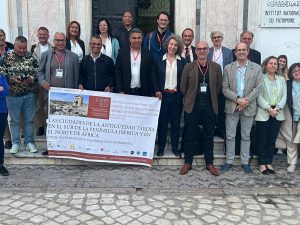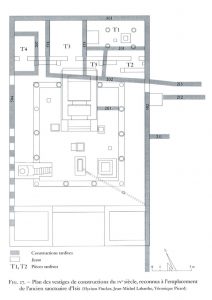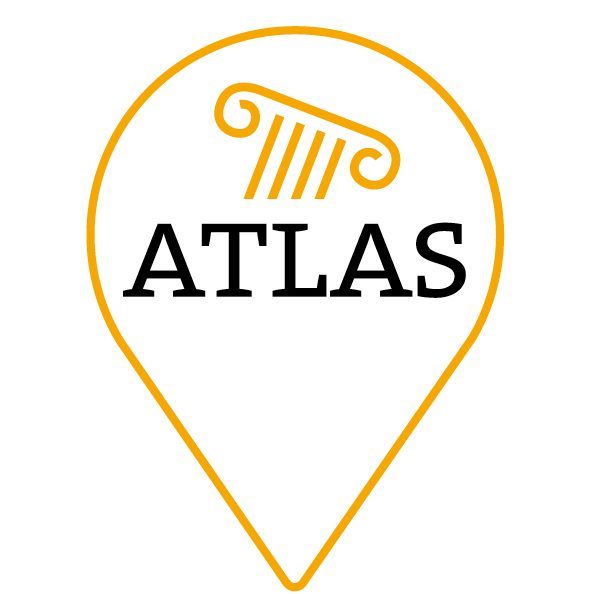Carrying out a research project in and about two different countries is both a challenge and a stimulating experience. It helps us to get to know the history of two places with different cultures and to get closer to their own idiosyncrasies, which undoubtedly enriches our professional and personal background. In fact, as you have seen over the years, ATLAS is allowing us to work not only in two different countries, but also with a number of different institutions, research teams and specialists.
Researching in two different countries
As you know, a large part of our research deals with the analysis of historical and archaeological heritage, including architectural remains and infrastructures, and topographical elements of late antique cities. For this reason, especially when we need direct information on these elements, we must turn to the different administrations and institutions responsible for the management and preservation, as well as the dissemination of this heritage. And, of course, each country (and each region) has its own institutions and ways of functioning. Therefore, knowledge of the procedures of each one of them is fundamental in an international project like ours, as it not only speeds up the necessary procedures but also allows us to establish reciprocal links by returning the knowledge generated to the institutions and society of origin.
In our specific case, in Tunisia we have worked hand in hand with the Institut National du Patrimoine, the main body responsible for looking after the country’s historical and archaeological heritage. In Spain, on the other hand, management is less centralised and in each region and city we have approached the corresponding institutions. Some cities even have more than one organisation working in the field of heritage, such as Mérida, where the Instituto Arqueológico de Mérida, the Consorcio Ciudad Monumental de Mérida and the Museo Nacional de Arte Romano converge.

Moreover, many of the archaeological sites examined in our project have also been the subject of campaigns and studies by different international teams. Probably the most obvious case is that of Carthage, where the international “Save Carthage“ campaign launched in the 1970s brought with it the arrival of research groups from many different countries. These teams not only carried out archaeological excavations in different parts of the ancient city, but many also published the results of their studies. Consequently, these results are collected in a large number of monographs, chapters and articles, often scattered, which we must gather together for our own research. A similar case can be found at Baelo Claudia. This site in Cádiz has a close link with France and the Casa de Velázquez, since the founder of the École des hautes études hispaniques, Pierre Paris, initiated the first archaeological campaigns at this site. But since then, many other teams have worked in this coastal Roman city, such as the University of Cadiz, the University of Seville and the University of Aachen.
That is why, in addition to contacting the different institutions in charge of heritage, on other occasions we have also contacted the teams and researchers who have led the excavations and studies of those elements for which we need more specific data. This is the case of the magnificent church of Damous-el-Karita, which was recently excavated by the Austrian team of Heimo Dolenz, the Christian epigraphy of Carthage studied exhaustively by Liliane Ennabli and Sihem Aloui, the multiple campaigns carried out in Leptiminus by the University of Michigan, or the excavations of the archaeological area of Morería directed by Miguel Alba.
Archaeological Reality
Another interesting difference that we, coincidentally, find in our case study cities is the continuity of habitation. Cartagena, Cordoba, Merida and Seville have developed on top of the original Roman cities; in other words, they are urban centres with a centuries-old occupational continuity. However, we only have a very partial knowledge of the ancient remains, which complicates archaeological research. Excavations are often only carried out when construction or repair work is being carried out on the buildings of the present-day city. So we end up with small windows of archaeological knowledge within the urban fabric, in some cases with the remains preserved and visible and in others simply documented and covered again by contemporary constructions. On the positive side, excavations tend to be of relatively small areas that allow us to document centuries of urban evolution. Of course, this means that archaeological remains are often found in complex stratigraphies, metres in extent, due to the use and reuse of preceding structures.

That said, one might think that the Tunisian sites in our project, which do not have contemporary cities above them, are easier to analyse. And indeed, we often have a more complete picture of the urban fabric of these ancient cities. Moreover, we can visit them and get a good idea of the buildings and the relationships between them and the rest of the urban infrastructures.
Fotografía del foro de Mactaris durante nuestra visita en marzo de 2022.
However, these sites present their own challenges. First of all, they are not completely abandoned, as new cities are often located in close proximity to the site in question. This is the case of Carthage, located between Tunis and Sidi Bou Saïd; Ammaedara, located east of modern-day Haïdra; or Lamta, next to ancient Leptiminus. Perhaps Mactaris is more similar to the Spanish cases of habitational continuity, given that it is enclosed by modern Makthar. Still, this proximity to modern cities is not always good for the preservation of archaeological sites. As an obvious matter of minimisation of effort and resources, it is very common for abandoned settlements to be used as quarries, resulting in the presence of numerous ancient materials (spolia) in the surrounding cities. So, for example, epigraphic information from these sites is very problematic. Indeed, a large number of inscriptions have been preserved, but their context is rarely known.
Another disadvantage of uninhabited sites is that they are more exposed to the weather and the passage of time. Thus, erosion affects not only the preservation of the buildings but also the stratigraphy, especially of the upper layers where the remains of more recent periods are found (and that includes our beloved Late Antiquity!). To this must be added, both on uninhabited sites and in living cities, the carrying out of interventions without archaeological methodology. However, the problem at uninhabited sites is that this type of intervention, which dates back to times when archaeology had not developed as a discipline, can affect a larger area of the ancient city. For example, in Baelo Claudia, our only depopulated case study in Spain, we have old excavation diaries that explain that dozens trucks loads with of earth that were removed during the excavations at the forum. The reason for this abundant extraction of earth is the interest in bringing to light the monumental buildings of the Early Imperial Roman period, to the detriment of other historical periods. Fortunately, however, this practice is now obsolete and today we have a large amount of information on late-antique urban evolution even in the most monumental areas of the city.

Despite the differences, or perhaps because of them, we have an interesting job. It is fun and intellectually stimulating to consider how the differences between our case studies impact on the representation of Late Antiquity. Moreover, it is certainly an important exercise for a project like ATLAS, as it allows us to better understand the development of historiographical narratives about our period of study.
